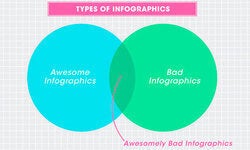Raconteur Media founder and CEO Freddie Ossberg explains why he feels that content marketers need to shape up

"Let's create an infographic!" Words I'm sure most of you have heard in (and probably before) the past year. But it seems that this medium of presenting data is reaching saturation point. I don't mean that infographics are becoming redundant, but that the use has become so widespread and mainstream that marketers have jumped on the bandwagon without a discerning analysis of whether it is an engaging tactic for communicating information.
Marketers know infographics can be advantageous. That's the good. But there is also the bad - and unfortunately - the ugly. Let's take a closer look at how this process is unfolding, what strategies to bear in mind, and what the future of infographics holds:
The Ugly (Design)
Web design entrepreneur Jeffrey Zeldman made a valid point: "Content precedes design. Design in the absence of content is not design, it's decoration." Companies can sometimes run headlong into the idea of an infographic without giving a second's thought to the design. It's best to remember that according to Visual.ly's definition of the term, infographics must have flow; they are meant to be visualisations of data that present complex information quickly and clearly. If your infographic is anything other than aesthetically beautiful, it would be best to rethink before publishing.
The Bad (Execution)
Sourcing: The sources of your data should always be cited, otherwise the end product will lack validity. This crucial element is missing from many examples I've come across and is not only cheeky, but downright insulting to the audience. One practice I would advise is to have a link in your infographic's data that demonstrates the source of the statistics. So if you're summarising findings, simply hyperlink individual figures back to their mention in the original report.
Narcissism: This may just be another bugbear of mine, but many companies insist on producing infographics about themselves - the content of which fails to interest 99% of the audience. If its purpose is internal, fair enough. Otherwise, see what you can do to create great, interesting, useful content - your audience will appreciate it.
Like the flow of any great story, a great infographic contains a beginning, a middle and an end, with an overarching narrative that makes the reader continue all the way to the bottom. We have seen a host of examples that lack clarity and therefore negate the benefits of ease and speed when it comes to consumption of data.
George Orwell famously wrote of the "contagion" within language to elaborate needlessly, while M&C Saatchi often spoke of the "brutal simplicity of thought" that underpins a lot of great advertising. The art of copywriting often lies in condensing complex ideas into concise points and the same ethos should apply to infographcis. Keep it simple, clear and creative.
Misperceptions: Companies are stuck thinking that bold presentation, small amounts of information, and icons only belong in the social media space. Sure, a cool infographic image that has been uploaded to Instagram, posted on Facebook and shared on Twitter is commonplace (well, almost). However, infographics are equally appropriate for presenting the findings of an agricultural report or the nuances of a sector's supply chain.
The Good (Messaging)
Data from Visual.ly shows that business infographics accounted for almost 13% of all infographics last year - more than any other topic. So, we can agree, smart companies are catching on.
The best examples of infographics set out to solve or comprehend a problem for time-poor audiences. Companies and brands are moving with the trend of how consumers are digesting information and this movement shows no signs of slowing down. As businesses aim to convey messages that contain elements of their philosophy and values, good infographics should also look to contain this information.
Those businesses creating infographics that aid others' understanding of complex issues not only portray themselves as informative but also as thought leaders within their sectors. Outstanding infographics can accrue notoriety for their makers as well as project the company's messaging with greater authority.
The Future
We believe that users' desire for accurate special interest content is increasing. The amount of information conveyed through infographics is rapidly expanding. Differentiation through animated and interactive infographics is a smart strategy for those companies at the frontiers of content strategy.
Ultimately, in the race to find new methods for presenting critical ideas or pertinent information, infographics are more and more embraced as the Holy Grail. However, it's worth remembering that without solid accreditation, great design, brevity and wit in execution, and right-place right-time deployment, even the most passionately conceived infographic won't help you achieve your content objectives.